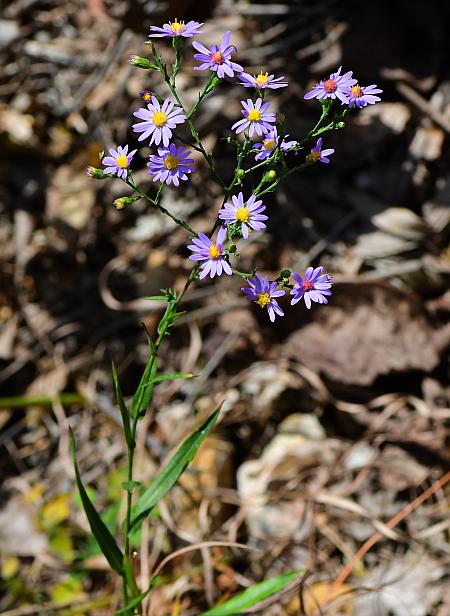Symphyotrichum laeve (L.) . Lve & D. Lve
Smooth Aster

Native
CC = 7
CW = 5
MOC = 54
© SRTurner
Symphyotrichum laeve (L.) . Lve & D. LveSmooth Aster | |
 |
Native CC = 7 CW = 5 MOC = 54 |
© SRTurner |
|
Family - Asteraceae/Astereae Habit - Perennial forb from creeping, relatively stout, woody rhizomes. Stems - Ascending to erect, to 1.2 m, single or multiple, branching above the midpoint, glabrous or very sparsely pubescent toward the tip and around the nodes, usually somewhat glaucous.
Leaves - Alternate, simple, mostly sessile and clasping. Basal and lower stem leaves sometimes absent at flowering, sessile or with short to long, poorly differentiated petioles. Median and upper stem leaves more or less progressively smaller toward the stem tip, sessile or the lowermost short-petiolate, slightly to strongly clasping the stem, the uppermost leaves sometimes somewhat sheathing, the blades 2-15 cm long, lanceolate to oblanceolate (often narrowly so) or oblong-oblanceolate, cordate to truncate at the base, angled or tapered to a sharply pointed tip, the margins entire or shallowly toothed, the surfaces glabrous, smooth, sometimes glaucous. Secondary veins on the leaf undersurface relatively easily observed, ascending and sometimes fused toward their tips, the veinlets relatively faint and forming a dense, irregular network of relatively short areoles.
Inflorescences - Open panicles of heads, sometimes with solitary heads or small clusters at the tips of relatively long, ascending branches, the heads appearing short-to long-stalked, the bracts leaflike, noticeably shorter than the adjacent foliage leaves, 0.3-0.8 cm long, narrowly lanceolate to linear.
Heads - Radiate, 1.5-3.0 cm in diameter at flowering. Involucre 5-8 mm long, the bracts in 4-6 unequal, overlapping series. Involucral bracts linear to narrowly oblong-oblanceolate, angled or relatively short-tapered at the sharply pointed, often reddish tip, the tip ascending, the slender midvein broadened abruptly above the often slightly thickened base in the apical 1/4-1/2 into an elliptic or diamond-shaped (2-5 times as long as wide), green tip, the outer surface glabrous, often somewhat glaucous, the margins sometimes sparsely hairy, especially toward the tip.
Florets - Ray florets 15-30 in 1 or 2 series, pistillate, the corollas well developed, 8-15 mm long, lavender to purple to bluish purple. Disc florets 15-40, perfect, the corollas 4.5-6.5 mm long, the slender portion of the tube noticeably shorter than the slightly expanded apical portion, the lobes 0.7-1.1 mm long, 18-25 percent of the total length of the expanded portion. Pappus bristles 4.5-6.0 mm long, off-white to pale cream-colored or light tan.
Fruits - Achenes 2-3 mm long, with 4 or 5 longitudinal ribs, purplish brown to brown, glabrous. Flowering - August - October. Habitat - Upland prairies, loess hill prairies, glades, ledges and tops of bluffs, upland forest openings, roadsides. Origin - Native to the U.S. Lookalikes - Numerous other purple-rayed species of Symphyotrichum. Other info. - This species of aster is found in scattered locations throughout Missouri. It is also found in some form across most of the continental U.S., although the var. laeve form ascribed to Missouri material is limited to the eastern half of the country. The purple-rayed flower heads are one of the last colorful flowers to appear, usually in mid fall, and their general appearance readily identifies the plants as asters. This particular plant is one of the more easily identified, by its long-tapered leaves which clasp at the base and are completely hairless and smooth. Photographs taken at Little Lost Creek Conservation Area, Warren County, MO, 10-9-2020 (SRTurner). |